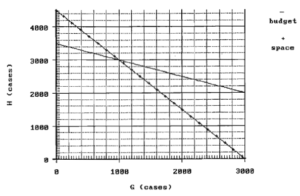2.5 Systems of Equations
If a number of equations involve the same variables, they are called a system of equations.
Example 2.5.1
An agent is to purchase two products, G and H, and send them to the company’s warehouse. He has a budget of $70,000 and truck space of 9,000 cubic meters. The product costs and sizes are as follows:
| Cost per Case | Volume per Case | |
| G | $10 | 3 m3 |
| H | $20 | 2 m3 |
The question to be answered here is: how much of each product should be purchased if both the budget and space are to be used up?
Key Takeaways
Limitations such as those for budget and space are called constraints. Each constraint gives an equation. To find the equation from the data given, you should consider the totals for each constraint separately and find the contribution of each variable. In this case; the variables are the amounts of each product to be bought. Let,
- g = the amount (number of cases) of G
- h = the amount (number of cases) of H
Then the budget constraint equation can be obtained by considering:
Similarly,
So,
Thus you have the system of equations
for which the graphs are given below.

Notice that the data for the problem was chiefly in terms of rates, the costs per case and the volume per case. These were used to get equations for totals, using the idea of,
for each equation. Notice, also, the use of the units of measurement to help keep track of the parts of the equations.
The values required by the problem are those of the point at which both equations are satisfied – the point on the graph at which the lines cross. This point is called the solution of the equations. It can be estimated from the graph and also calculated from the equations.
To solve the equations, using the method of elimination write each one in the form for which h is given as a function of g.
For the budget: h = 3,500 − 0.5g
For the space: h = 4,500 − 1.5g
Next, note that at the solution, the values of h must be the same, so:
By adding
Subtracting $3,500 from each side gives:
Substituting the result in one of the original equations (space):
Whence
Thus, both the budget and space allowances will be used up if 1,000 cases of G and 3,000 cases of H are bought.
The method of substitution gives you another way of solving such equations. It consists of the following:
Once the first equation has been solved for h, the result is
This result would be substituted in the second equation, which would produce an equation containing only the variable g.
Thus,
and
Substituting in the other equation:
Knowledge Check 2.3
One of the production facilities of Jones Furniture Company produces chairs from kits, each of which contains all the parts for the chair. The facility makes two types of chairs: a regular chair for normal inside use and a special chair for outside use. Each chair is assembled and then painted.
There is only a limited amount of labor time for each operation: 120 hours per week for assembly, 80 hours per week for painting. Each regular chair requires 0.5 hours for assembly and 0.3 hours for painting. Each special chair requires 0.4 hours for assembly and 0.4 hours for painting.
Find the number of regular and special chairs that would have to be produced each week in order to use up both the assembly and painting time available for that week.
Let,
r = number of regular chairs produced per week
s = number of special chairs produced per week
- Find the equation that shows the constraint for the available assembly time: _______ (total hours) = _______ _(hours/chair) × r (chairs) + _______ (hours/chair) × s (chairs)
- Find the equation that shows the constraint for the available painting time: ? = ? × r + ? × s
- Solve the equation in Question 1 for r and substitute the result in the second equation, in Question 2, to get the value for I.
- Substitute the result from Question 3 in one of the equations to get the value of r.
- Check your results by placing them in the other equation (but not the one in Question 4) and see that they give the correct value.
- Graph the two equations to make a visual check of your answer.
Your Own Notes
- Are there any notes you want to take from this section? Is there anything you’d like to copy and paste below?
- These notes are for you only (they will not be stored anywhere)
- Make sure to download them at the end to use as a reference
A number of equations, involving the same variables
A method of solving a system of equations.

